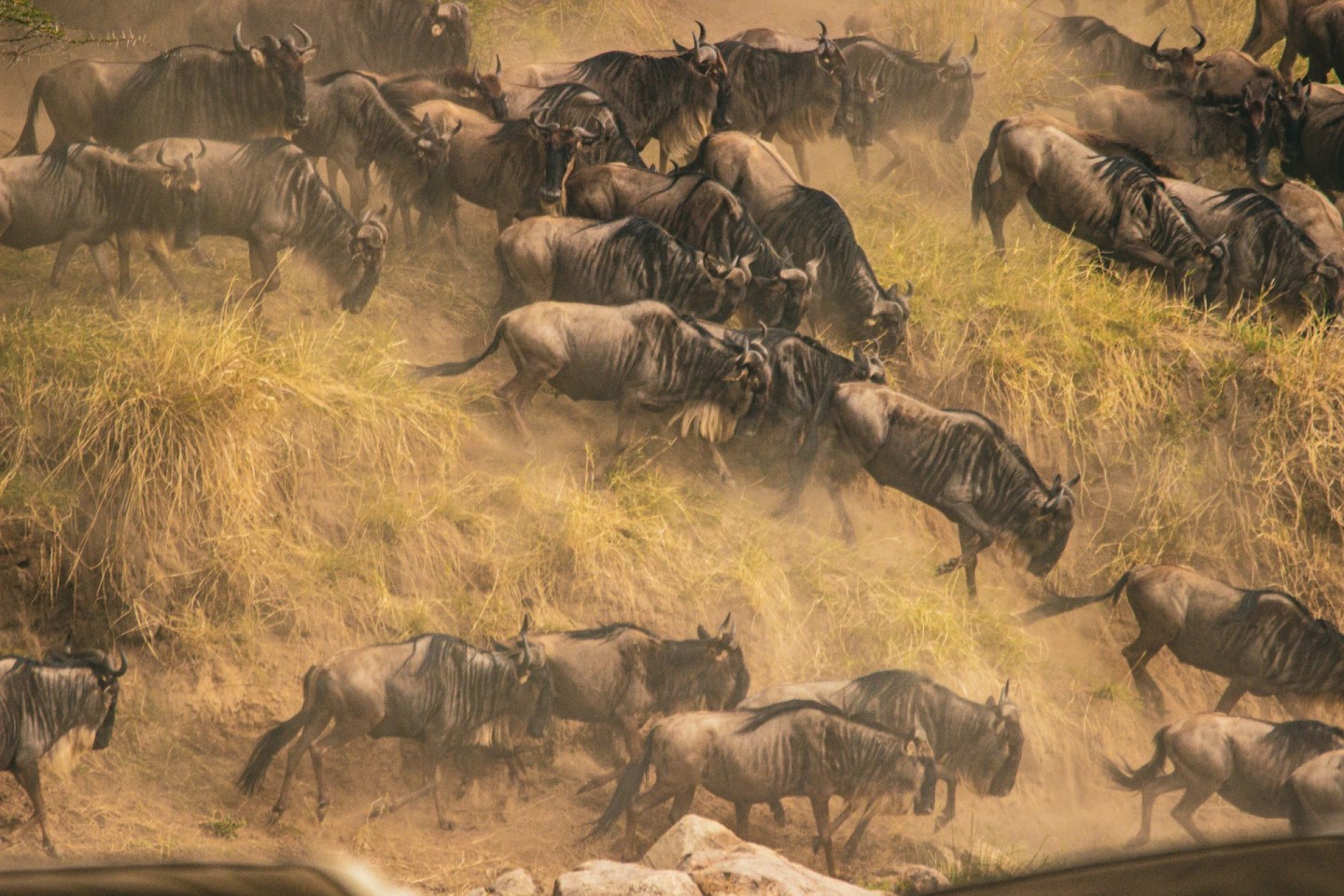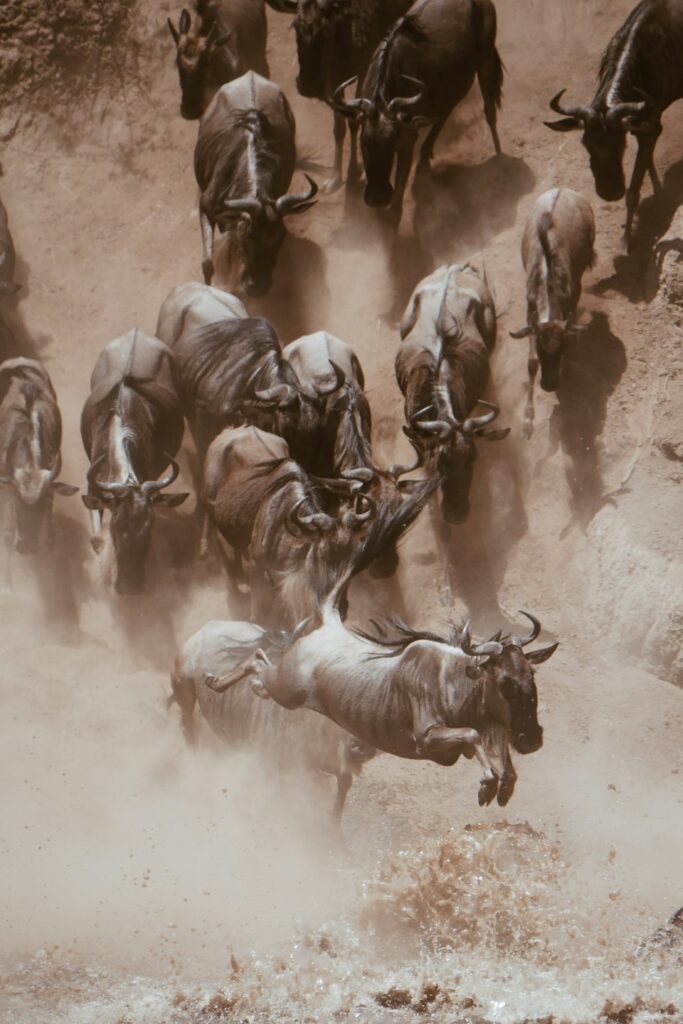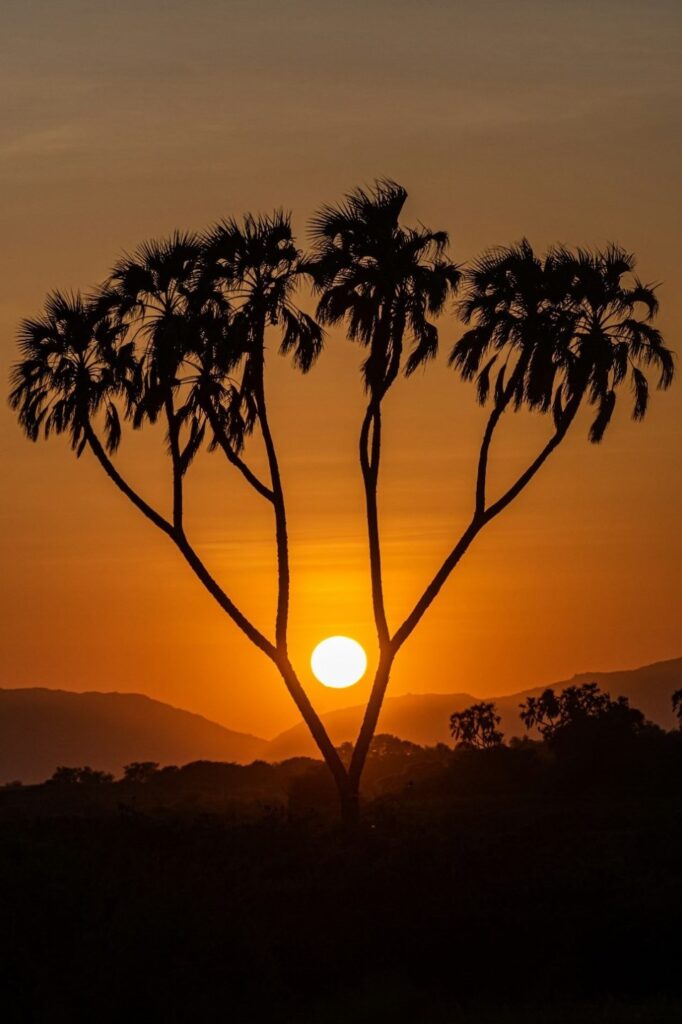
Facts About the Great Wildebeest Migration
Facts About the Great Wildebeest Migration – Popularly known as ‘the greatest show on earth’, the phenomenon wildebeest migration sees mega herds of almost two million wildebeest, alongside the common zebras and gazelles continuously traveling for thousands of kilometers in a broadly clockwise direction from the southern Serengeti plains in Tanzania, north into Kenya’s Maasai Mara, and back again.
For the beginning of time, this has been the trend and it will remain so for many more years into the future. In the face of humanity, the migration has remained to stand out as one of Africa’s classical safari experiences, drawing visitors year round to witness this magnificent wildlife spectacle.
These migration geniuses, the wildebeest, also called gnus, are members of the antelope family. Closely related to oryxes and gazelles. A wildebeest can grow to 2.4 meters in length, and weigh up to 270 kilograms. Wildebeest typically inhabit the Serengeti plains of southeastern Africa.
For most of their lives, wildebeest graze in the grassy savannahs and open woodlands of the plains, which straddle the nations of Tanzania and Kenya. More than 1.5 million wildebeest migrate in an enormous annual trek of life.
The annual migration northwest, at the end of the rainy season, usually in July to October is recognized as one of the “Seven Wonders of the Natural World.” The search for greener pastures and water does not come without danger.
Always on the move, the herds experience the full circle of life, from mating, to calving, to death. Their movement has been an attraction to many predators: the general clumsy while on land, crocodiles, and the majestically ravaging scavengers and to the swift big cats alike. All these do come out annually to partake on what Mother Nature cause brings on their food menu.
This endless journey in search of pasture and water sees herds splitting up to form small coalitions that lead to reformations of even bigger herds later as they retrace their steps while matching onwards and this can make the whole pattern more chaotic than it might at first seem. For decades, it has been thought that the herds follow the rains and this hasn’t been very correct every year. Every year, the timing and routes that they take differ, making the precise location for a migration safari somewhat tricky to predict.
Always on the move, the herds experience the full circle of life, from mating, to calving, to death. Their movement has been an attraction to many predators: the general clumsy while on land, crocodiles, and the majestically ravaging scavengers and to the swift big cats alike. All these do come out annually to partake on what Mother Nature cause brings on their food menu.
This endless journey in search of pasture and water sees herds splitting up to form small coalitions that lead to reformations of even bigger herds later as they retrace their steps while matching onwards and this can make the whole pattern more chaotic than it might at first seem. For decades, it has been thought that the herds follow the rains and this hasn’t been very correct every year. Every year, the timing and routes that they take differ, making the precise location for a migration safari somewhat tricky to predict.
1. Understanding About the Wildebeest Migration
Most people think that the Wildebeest Migration only takes place between July and October, but it’s actually an ever-moving, circular migration with various but equally exciting events that occur year-round. The popular river crossings usually coincide with safari’s high season (June to October), hence the perception that this is the only time of the year that the wildebeest are on the move or can be seen.
2. The Best Sightings
Viewing the wildebeest migration exclusively when you are having the well experienced guide who has the great migration and the best idea on how the activity is best done. Good guiding can make your safari the great one with the unforgettable safari memories, as they keep you off the beaten track such that you can have the exclusive sighting. Read more about the Wildebeest and the River Crossings
3. Book Early
We recommend at least 6 months to a year in advance. Luxury lodges and safari camps fill up fast, especially for the Great Wildebeest Migration safari from June to October. Remember, this is safari’s high season in Kenya and when the popular river crossings happen, but you can see the herds any time of the year.
4. Careful Planning and Execution
Nobody knows or understand the migration pattern any better. The migration is confusing and fluid, often-unpredictable natural phenomenon. It’s important to know where to go and when to go on a Wildebeest Migration Safari to ensure your expectations are met. Choose and arrange your timing according to what you want to see and experience. Our golden tip is that have a healthy discussion about it with our holiday designer experts.
5. Wildebeest Migration and the Safari Crowd
During the migration period, both the Maasai Mara National Reserve and Serengeti National Park experience high number of guests and vehicle numbers are equally high. In Kenya, the peak or high season is June to October.
The best way to avoid the crowds is to consider having a stay in the privately owned nature conservancies that adjoin the Maasai Mara. They come at a premium cost and in return, they offer exclusivity, uncompromised level of luxury accommodation and excellently unlimited wildlife viewing in the exclusive-use areas. They also offer activities not permitted in the main reserve, such as night drives, bush walks and much more.
For the Serengeti sector, there are camps that are tucked a little further away from the migration hot spots. This guarantees you to capture all the action with very little disturbance and allow you to have some tranquil nights.
6. Blend Your Wildebeest Migration Safari
The wildebeest migration gets emotional, engaging, noisy, chaotic, smelly, and very different from the traditional BIG 5 safari. Away from the main migration safari and the general Big 5 safari, we highly recommend ending at a lodge or camp that’s located away from the herds to enjoy a bit of tranquility and a diverse game viewing and other safari experiences.
7. Choose The Right Safari Vehicle
For the great wildebeest migration safari, we use a combination of vehicles for their uniqueness and flexibility that has enough characteristics useful for photographers to take a great picture in every angle. It’s also possible to request for an exclusive custom Photography Safari Vehicle for your family, as a couple, or small group safari.
Our vehicles come in 6 seats Safari Land Cruiser for families or small group guests, and 4 seats for one lovely couple on safari, also we offer a long base Safari Land Cruiser for couples. This type of safari vehicle design is a common custom vehicle in Kenya and Tanzania but we characterized them in new edge designs to offer an absolutely luxury experience.
8. Having the Right Guide
Your African luxury safari isn’t complete without the guides. It could be that you’re in Africa for a special occasion, the Big 5 safari or a special interest. For that African luxury safari’s success, there are great people who will make it happen – from the wildlife trackers, community guides and your able safari guides.
During your African luxury safari, your guide will form the most important part of your every day on safari. His (or her!) knowledge of our handpicked destination you’re visiting, activities to undertake and the wildlife you’ll see will make your African luxury safari experience complete.


The Annual Migration Calendar - Where and When...
The wildebeest migration safari isn’t your ordinary Big 5 safari, as nature does keep and follow its own time. In the recent years, even some of the veteran wildlife moviemakers and photographers who have participated in the well-documented river crossings have failed to predict when and where.
Thankfully, it’s the unpredictability of the migration, the expected river crossings reward the ever-patient safari guides, and the seasoned guests on how best how to enjoy the vast savannahs while waiting for the dramatic river crossings and predator actions that can be delayed for hours to days. In this case, good planning and patience are the golden rules.
The weather pattern is key to this natural phenomenon as the rains determines how the event unfolds so many kilometers behind. With the coming of the rains, tracking the herds is not an exact science, but the same general pattern that has been showcased year in year out. Again, note that the rain could delay and this contributes to the outcome of the migration itself.





Wildebeest Migration and River Crossings
When people say they’ve come to see the migration, they really mean they have come to see the river crossings. Watching the wildebeest hurl themselves into the water from some jaw-dropping steep riverbanks, one after the other, in a flurry of panic, sends a surge of adrenaline through the most seasoned guests.
Many guests have only watched at the river crossings scenes on Planet Earth – the chaotic clamber of wildebeests, zebras and a few antelope species across turbulent crocodile-infested waters of the Mara River. For the successful ones, the hyenas, lions and leopards lurk amongst the riverine bushes to ambush unsuspecting victims of which a good number succumb to these abled cats. Please, read more about the River Crossings
Why Book Your Wildebeest Migration Luxury Safari With Oluokos,
Our guests tend to ask what the perfect Wildebeest Migration Luxury Safari itinerary looks like and to be honest, we don’t have a straight-forward answer. To answer you in brief, each guest has a unique taste when it comes to enquiring about the wildebeest migration safari and this could be based on personality that’s strongly influenced by expectations. We have given a few good to check itineraries to serve as wildlife migration inspirations.
We don’t offer Wildebeest Migration Safari as a bucket list destination, but a rich wildlife safari experience with diversity, meaningful purpose to travel, cultural mosaic and of course, unmatched habitats that have given room to wildlife migration.
To many, The Great Wildebeest Migration is a living testimony about nature’s resilience, majesty and sustainability. This annual journey, undertaken by over two million wildebeest, zebras, and antelope across the vast plains of Kenya and Tanzania, is a spectacle that captivates guests from all walks of lives. Let Oluokos Signature bring you closer to the ever-unfolding natural spectacle with an exclusive, front-row seat to one of nature’s greatest shows on Earth.





